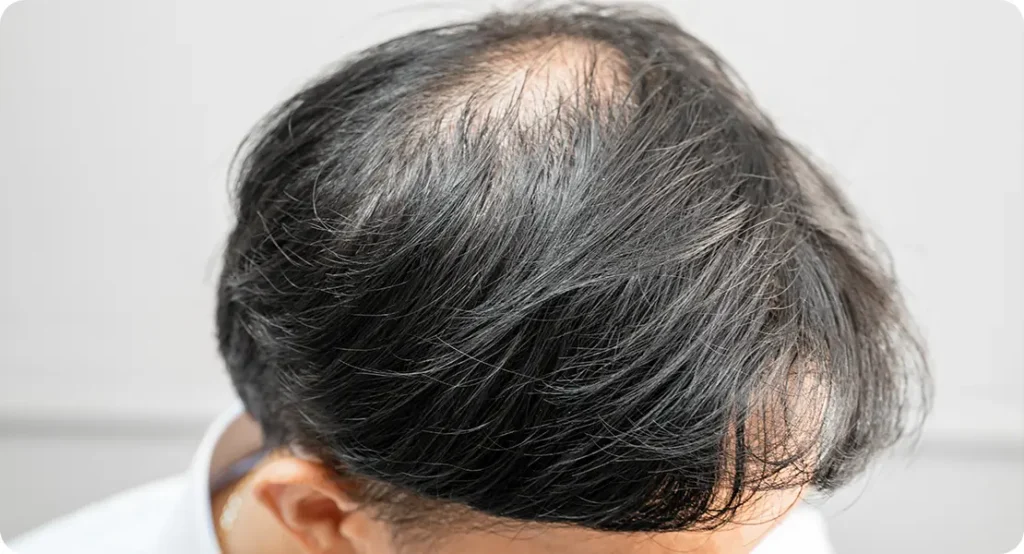If you’ve suddenly started losing handfuls of hair, it’s completely normal to feel worried, confused, or even scared. I know how overwhelming it can feel when your hair starts shedding faster than usual, especially when you weren’t expecting anything out of the ordinary. Sudden alopecia often appears without warning, and it may leave you wondering whether something serious is going on.
The good news is that fast-onset hair loss is usually triggered by factors that can be identified and treated. Your body reacts strongly to internal changes, and your hair follicles are one of the first things to show that something is off. Whether it’s stress, illness, hormones, medication changes or diet issues, sudden shedding almost always has a root cause.
In this guide, I’ll help you understand why rapid hair loss happens, what the most common triggers are, and what signs show you it’s time to see a dermatologist. My aim is to make this whole experience feel less frightening and give you the clarity you need to take your next step with confidence.
Understanding Sudden Alopecia
Sudden alopecia simply means hair loss that begins quickly, often within days or weeks. You might notice extra hair falling out in the shower, on your pillow, in your brush, or even when you run your fingers through your hair.
You may also experience:
- Thinning at the crown
- Widening of your part
- Clumps of hair shedding
- Increased hair on clothing
- Sudden patches appearing
Unlike gradual thinning, sudden alopecia usually means your hair follicles have switched into a shed phase all at once, often reacting to a trigger.
The Most Common Causes of Sudden Rapid Hair Loss

There are several well-known triggers that can set off fast shedding. Below, I’ll go through the ones you’re most likely to encounter.
1. Telogen Effluvium: The Number One Cause of Sudden Hair Loss
If you’re losing hair all at once, there’s a high chance it’s Telogen Effluvium.
What is Telogen Effluvium?
It’s a condition where a large number of hair follicles move prematurely into the “telogen” or resting phase. About two to three months later, those hairs shed all at once.
Typical triggers include:
- High stress
- Sudden weight loss
- Major illness
- Fever or viral infection
- Surgery
- Nutritional deficiencies
- Hormonal changes
- Medication changes
What the shedding looks like
- Hair coming out in handfuls
- Increased daily fall (200–500 hairs)
- No bald patches
- Diffuse thinning across the whole scalp
The good news? Telogen Effluvium is usually temporary. Your follicles remain alive and capable of regrowth once the trigger is addressed.
2. Emotional and Physical Stress
Your body reacts strongly to stress, and your hair follicles are very sensitive to hormonal changes that stress creates.
Types of stress that trigger sudden shedding:
- Relationship or emotional stress
- Work burnout
- Grief
- Anxiety episodes
- Physical trauma
- Sudden lifestyle disruption
Why stress causes hair loss
Stress pushes follicles into the resting phase, meaning they stop growing. After a delay, they fall out all at once.
If you’ve been through a stressful event in the past few months, it could be directly connected to your sudden alopecia.
3. Illness, Fever and Viral Infections
Any illness that disrupts your immune system or metabolism can lead to sudden hair loss. Even a moderate fever can trigger shedding weeks later.
Common illnesses linked to sudden hair loss include:
- COVID-19
- Influenza
- Thyroid disorders
- Autoimmune conditions
- Anaemia
- Severe infections
- Chronic inflammation
What you might notice
- Hair shedding two to three months after illness
- Thinning around your crown
- Hair feeling weaker or drier
Your hair responds to internal distress much later, making the connection easy to miss.
4. Medication Changes
Your hair is affected by any medication that influences hormones, inflammation, metabolism or immunity.
Medications commonly linked to sudden shedding include:
- Antidepressants
- Blood thinners
- Thyroid medications
- Contraceptive pills
- Acne medications like isotretinoin
- Blood pressure tablets
- Steroids
- Hormone therapy
Why this happens
New medications can shock the follicle cycle or alter hormone balance. Stopping a medication abruptly can have a similar effect.
If you recently changed, started or stopped a medication, this could be a major clue.
5. Nutritional Deficiencies and Crash Diets
Your hair reflects your nutritional health. If your body isn’t getting enough nutrients, your hair is one of the first things affected.
Deficiencies linked to sudden hair loss include:
- Iron deficiency
- Vitamin D deficiency
- Protein deficiency
- Vitamin B12 deficiency
- Zinc deficiency
- Omega-3 deficiency
Crash diets and rapid weight loss can also trigger Telogen Effluvium.
Signs it may be nutrition-related
- Fatigue
- Brittle hair
- Pale skin
- Weak nails
- Light-headedness
Your hair can recover once the deficiency is corrected.
6. Hormonal Shifts and Imbalance
Hormones control your hair cycle, so any sudden change can cause dramatic shedding.
Common hormonal triggers include:
- Post-pregnancy shedding
- Stopping breastfeeding
- Menopause
- PCOS
- Thyroid imbalances
- Starting or stopping hormonal birth control
Hormonal alopecia can appear suddenly and may require medical intervention to stabilise.
7. Post-Pregnancy (Postpartum) Hair Loss
This is one of the most common causes of sudden shedding in women.
Why postpartum alopecia happens
During pregnancy, your hair stays in the growth phase because of high oestrogen. After childbirth, hormone levels drop rapidly, causing massive shedding all at once.
Good news
Postpartum shedding is temporary and usually resolves within six to 12 months.
8. Sudden Patchy Loss: Alopecia Areata
If you’re seeing circular or oval bald patches, sudden scratch-sized areas of hair loss, or spots where hair falls out overnight, it may be alopecia areata.
Characteristics of alopecia areata include:
- Round patches
- Sudden appearance
- Smooth, hairless skin
- Regrowth that may be white at first
Alopecia areata is autoimmune, meaning your immune system attacks your follicles.
What you should know
- It can appear at any age
- It can improve or worsen unpredictably
- Early treatment improves long-term outcomes
This condition nearly always requires professional support.
9. Sudden Hair Loss After Stopping Tight Hairstyles

Traction alopecia develops from years of tension on the hair. But the shedding can sometimes happen suddenly when follicles finally give out.
Common causes
- Tight braids
- Weaves
- Ponytails
- Extensions
- Repeated pulling or tension
If the tension continues too long, follicles can become permanently damaged.
10. Scalp Inflammation or Infection
Anything that irritates or inflames the scalp can cause sudden shedding.
Possible triggers:
- Fungal infections
- Seborrhoeic dermatitis
- Psoriasis
- Contact dermatitis
- Bacterial infections
- Allergic reactions
You may notice itching, redness, scaling or tenderness.
Treating the underlying scalp condition often stops the shedding quickly.
What Does Sudden Hair Loss Look Like?
Not all sudden alopecia looks the same. Here’s how to understand what you’re experiencing.
Diffuse Thinning
This is when hair falls evenly from all over the scalp. It’s common in Telogen Effluvium, stress-related shedding and nutritional deficiencies.
Patchy Loss
This usually means alopecia areata or traction alopecia.
Shedding in Clumps
This often indicates a strong trigger stress, illness or medication changes.
Receding or Pattern Changes
This may show underlying genetic hair thinning that’s been accelerated by stress or hormones.
How to Know Whether Your Hair Loss Is Temporary or Serious
Sudden shedding is usually temporary, but some signs indicate you should seek professional advice quickly.
These signs are important:
- Visible bald patches
- Hair falling out in large clumps
- Rapid thinning over days or weeks
- Itchiness or burning on the scalp
- Hair loss with unexplained fatigue
- History of autoimmune illness
- Persistent shedding beyond three months
A dermatologist can identify the root cause accurately and start an appropriate treatment plan.
When to See a Dermatologist
If your hair loss is causing distress, affecting your confidence, or happening very quickly, it’s worth booking a consultation.
You should especially see a dermatologist if:
- The shedding is severe or sudden
- You notice bald patches
- You are unsure what triggered it
- It continues for longer than eight to twelve weeks
- You are experiencing symptoms like fatigue, irregular periods or weakness
- You suspect alopecia areata or hormonal imbalance
Early diagnosis gives you the best chance of regrowth.
What Your Dermatologist Might Check
A dermatologist will usually take a detailed history and may recommend the following:
Blood tests for:
- Iron levels
- Vitamin D
- Thyroid function
- Hormone levels
- Inflammatory markers
- B12 and folate
Scalp examination
They’ll check for inflammation, patches, miniaturisation and signs of infection.
Hair-pull test
This helps assess your active shedding phase.
Trichoscopy
A magnified examination of hair follicles.
Biopsy (if needed)
Only used when diagnosing scarring alopecia or autoimmune involvement.
Most Effective Treatments for Sudden Alopecia
The treatment you need depends on the underlying cause.
1. Treating Telogen Effluvium
- Address the trigger
- Supportive supplements
- Low-level laser therapy
- Gentle scalp care
- Stress reduction
- Adequate protein intake
Once the trigger is resolved, your hair usually regrows naturally.
2. Treating Stress-Related Hair Loss
- Lifestyle changes
- Stress-reduction techniques
- Therapy or support
- Supplements like magnesium or omega-3
- LLLT for stimulation
calming your nervous system can dramatically improve your hair cycle.
3. Post-Illness or Post-Fever Hair Loss
- Anti-inflammatory diet
- Addressing deficiencies
- Scalp treatments
- Gentle topicals
- Patience as your body recovers
This type of shedding often resolves within six months.
4. Treating Alopecia Areata
- Corticosteroid injections
- Topical immunotherapy
- New JAK inhibitor treatments
- PRP
- Exosomes
- Anti-inflammatory scalp care
Early intervention leads to better outcomes.
5. Medication-Related Hair Loss
- Dose adjustments
- Switching medication with medical advice
- Strengthening treatments
- Anti-shedding serums
Never stop medication without consulting your doctor.
6. Treating Hormonal Hair Loss
- Thyroid balancing
- PCOS management
- Hormone testing
- Scalp stimulation
- Dietary changes
Hormonal alopecia requires targeted treatment for long-term improvement.
7. Fixing Nutrition-Related Shedding
You may need:
- Iron supplements
- Vitamin D
- B12
- Zinc
- Enough protein in your diet
Your hair needs nutrients to grow, and deficiencies can cause dramatic shedding.
How Long Does Sudden Hair Loss Last?
In most cases, sudden shedding lasts:
- 6–12 weeks for Telogen Effluvium
- Up to 6 months for stress or illness
- Longer for autoimmune alopecia
Regrowth usually begins once the underlying cause is addressed.
Self-Care Tips to Support Recovery
You can support your hair regrowth with simple steps, such as:
- Eating enough protein
- Taking essential vitamins
- Avoiding tight hairstyles
- Limiting heat styling
- Using gentle shampoos
- Reducing stress
- Getting enough sleep
- Staying hydrated
Small changes can make a big difference in how strong and healthy your regrowth becomes.
FAQs:
1. What exactly is sudden alopecia and how is it different from normal shedding?
Sudden alopecia refers to hair loss that begins abruptly, often within a few days or weeks, and is far more noticeable than the usual 50–100 hairs you lose per day. Instead of gradual thinning, you may see clumps of hair falling out, increased shedding during showers, or visible thinning across the scalp. This rapid shift usually means your follicles have entered the shedding phase together due to a trigger such as stress, illness, hormonal changes or nutritional imbalance. Normal shedding is slow and steady, whereas sudden alopecia feels dramatic and unexpected.
2. Why does hair fall out all at once when something triggers sudden alopecia?
Your hair cycle is highly sensitive to internal changes. When the body experiences a shock whether emotional, physical, or metabolic it can push a large number of follicles into the resting phase at the same time. Since hairs stay in this phase for about two to three months before falling out, you often notice heavy shedding long after the trigger occurred. This delayed shedding makes the cause harder to identify but also explains why sudden alopecia appears out of nowhere.
3. Can stress alone really cause rapid hair loss?
Yes, severe or prolonged stress can absolutely trigger sudden alopecia. Stress causes hormonal fluctuations and inflammation that interrupt the normal growth cycle of your follicles, forcing them to stop producing new strands. After a few weeks or months, these stressed follicles release the hairs they were holding onto, creating noticeable shedding. Even emotional events like grief, anxiety spikes or burnout can have the same impact as physical stress.
4. How do I know if my sudden hair loss is because of an illness or fever?
If your shedding started two to three months after an illness especially one involving high fever, inflammation, or viral infection then it is very likely linked to your recovery period. When the body is fighting illness, its priority shifts to essential functions, and hair growth temporarily slows down. Once the illness resolves, the body “restarts” the hair cycle, causing a sudden wave of shedding as the follicles reset. This is very common after conditions like COVID-19, thyroid issues and severe infections.
5. Can switching medications trigger sudden hair loss?
Yes, both starting and stopping certain medications can cause rapid shedding. Drugs that influence hormones, immunity, blood flow or metabolism can disrupt the follicle cycle. Even changing the dosage of a long-term medication may shock the system enough to trigger shedding. The hair loss usually begins weeks after the change, and although it looks alarming, it often improves once your body adjusts to the medication again.
6. Is postpartum hair loss actually sudden alopecia?
Postpartum shedding is a specific type of sudden alopecia because the change in hormone levels after childbirth happens very quickly. During pregnancy, high oestrogen keeps your hair in the growth phase, giving you thicker volume. Once you give birth, these levels drop sharply, causing a mass release of hair that had been held in place. The shedding typically begins between two and four months after delivery and is completely normal and temporary.
7. How do I know if my sudden hair loss is alopecia areata?
Alopecia areata is most likely when the hair loss appears in smooth, round or oval patches rather than evenly across the scalp. You may notice a small patch one day and a larger one shortly after, or several scattered areas developing at once. The skin in these patches usually looks normal but has no hair. Because alopecia areata is autoimmune, the shedding can happen overnight or progress unpredictably. A dermatologist can confirm the diagnosis with a visual examination or sometimes a biopsy.
8. Can sudden alopecia become permanent if not treated quickly?
Most forms of sudden alopecia are temporary, especially when caused by stress, diet, illness or postpartum changes. However, certain conditions such as untreated traction alopecia or autoimmune alopecia that becomes aggressive can lead to long-term follicle damage if ignored for too long. The earlier you understand the cause and begin treatment, the better your chances of full regrowth. Delayed intervention increases the risk of prolonged or incomplete recovery.
9. How long does it usually take for sudden alopecia to stop?
The duration depends on the trigger, but most people experience active shedding for a few weeks to a few months. Telogen Effluvium typically lasts six to twelve weeks before slowing down, while shedding from stress or illness can continue for up to six months. Autoimmune-related alopecia can fluctuate for longer periods. Remember that shedding stops first, and then regrowth begins gradually over the following months.
10. What’s the first thing I should do if I notice sudden heavy shedding?
The most important first step is not to panic, because panic itself can worsen the shedding. Instead, think about what has happened in your life over the past eight to twelve weeks any illness, stress, diet change, weight loss, medication adjustment or hormonal shift. Identifying the trigger helps you understand what is happening. If you cannot find a clear cause, if shedding is very rapid, or if you notice bald patches or symptoms like fatigue, it’s best to see a dermatologist promptly for proper diagnosis and treatment.
Final Thought: Taking Control of Sudden Hair Loss
Sudden alopecia can be deeply unsettling, especially when you don’t know why it’s happening or how long it will last. But in most cases, rapid shedding has an identifiable cause and is fully reversible once the underlying trigger is addressed. Whether the issue is stress, illness, nutritional changes, hormones or an autoimmune condition, getting clarity early makes a huge difference to how quickly your hair can recover.
If your shedding feels severe, is affecting your confidence, or isn’t slowing down after several weeks, it’s worth speaking to a specialist who can guide you through your next steps. You can get in touch with us at the London Dermatology Centre to book a consultation with one of our experts if you’re looking for Alopecia treatment in London and want personalised support tailored to your specific needs.
References:
1. Hughes, E., Syed, H. & Saleh, D. (2025) ‘Telogen effluvium’, StatPearls Publishing https://pubmed.ncbi.nlm.nih.gov/28613598/
2. Sinclair, R. & Liyanage, D. (2019) ‘Telogen Effluvium’, Cosmetics, https://www.mdpi.com/2079-9284/3/2/13
3. Pau, M. & Abedel, O. (2021) ‘SARS-CoV-2 infection a trigger factor for telogen effluvium: review of the literature with a case-based guidance for clinical evaluation’, Life (Basel), 13(7), 1576. https://www.mdpi.com/2075-1729/13/7/1576
4. Lozano-Camacho, A., Quereda, M.A., Pericacho, M. & Garcia-Lozano, I. (2021) ‘Telogen effluvium: a review of the science and current obstacles’, Journal of the European Academy of Dermatology and Venereology, https://pubmed.ncbi.nlm.nih.gov/33541773/
5. Kang, H., Kim, Y. & Kim, Y. (2022) ‘Serum vitamin B12 in chronic telogen effluvium patients: a case–control study’, Journal of Dermatology and Dermatologic Surgery, https://journals.lww.com/jdds/fulltext/2022/26020/serum_vitamin_b12_in_chronic_telogen_effluvium.2.aspx
